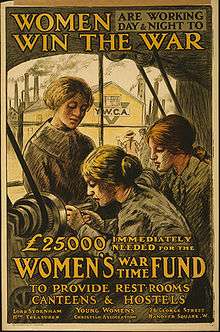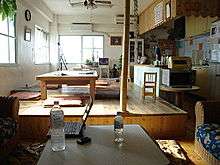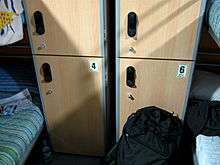Hostel

Hostels provide budget-oriented, sociable accommodation where guests can rent a bed, usually a bunk bed, in a dormitory and share a bathroom, lounge and sometimes a kitchen. Rooms can be mixed or single-sex, and private rooms may also be available.
Hostels are often cheaper for both the operator and occupants; many hostels have long-term residents who they employ as desk agents or housekeeping staff in exchange for experience or discounted accommodation.
In India, Pakistan and South Africa, hostel also refers to boarding schools or student dormitories in resident colleges and universities. In other parts of the world, the word hostel mainly refers to properties offering shared accommodation to travellers or backpackers.
History

In 1912, in Altena Castle in Germany, Richard Schirrmann created the first permanent Jugendherberge or "Youth Hostel." These first youth hostels were an exponent of the vision of the German Youth Movement to let poor city youngsters breathe fresh air outdoors. The youths were supposed to manage the hostel themselves as much as possible, doing chores to keep the costs down and build character, and be physically active outdoors. Because of this, many youth hostels closed during the middle part of the day.
Differences from hotels

There are several differences between hostels and hotels, including:
- Hostels tend to be budget-oriented; rates are considerably lower, and many hostels have programs to share books, DVDs and other items.
- For those who prefer an informal environment, hostels do not usually have the same level of formality as hotels.
- For those who prefer to socialize with their fellow guests, hostels usually have more common areas and opportunities to socialize. The dormitory aspect of hostels also increases the social factor.
- Hostels are generally self-catering.
- Hostels normally close during the day to keep down cost (for the customer and the hostel).
Communal accommodation

There is less privacy in a hostel than in a hotel. Sharing sleeping accommodation in a dormitory is very different from staying in a private room in a hotel or bed and breakfast, and might not be comfortable for those requiring more privacy. Hostels encourage more social interaction between guests due to the shared sleeping areas and communal areas such as lounges, kitchens and internet cafes.
Care should be taken with personal belongings, as guests may share a common living space, so it is advisable to secure guests' belongings. Most hostels offer some sort of system for safely storing valuables, and an increasing number of hostels offer private lockers; there are other things to consider as well when choosing a safe hostel, such as whether they have a guest curfew, uphold fire codes, 24-hour security, and CCTV.
Noise can make sleeping difficult on occasions, whether from snoring, talking, sexual activity, someone either returning late or leaving early, or the proximity of so many people. To mitigate this, some wear earplugs and/or sleeping masks.
Self-contained facilities and services
In attempts to attract more visitors, many hostels nowadays provide additional services not previously available, such as airport shuttle transfers, internet cafés, swimming pools and spas, tour booking and carfree hire. Some hostels may include a hot meal in the price.
Types

The traditional hostel format involved dormitory style accommodation. Some newer hostels also include en-suite accommodation with single, double or quad occupancy rooms, though to be considered a hostel they must also provide dormitory accommodation.[1][2] In recent years, the numbers of independent and backpackers' hostels have increased greatly to cater for the greater numbers of overland, multi-destination travellers (such as gap-year travellers and rail-trippers).
The quality of such places has also improved dramatically. While most hostels still insist on a curfew, daytime lockouts, very few require occupants to do chores apart from washing and drying up after food preparation.[3]
Hostelling International (HI)
Richard Schirrmann's idea of hostels rapidly spread overseas and eventually resulted in Hostelling International, an organisation composed of more than 90 different youth hostel associations representing over 4,500 youth hostels in over 80 countries.[4]
Some HI Youth Hostels cater more to school-aged children (sometimes through school trips) and parents with their children, whereas others are more for travellers intent on learning new cultures. However, while the exploration of different cultures and places is emphasised in many hostels, particularly in cities or popular tourist destinations, there are still many hostels providing accommodation for outdoor pursuits such as hillwalking, climbing and bicycle touring; these are often small friendly hostels retaining much of the original vision and often provide valuable access to more remote regions.
In the past several years, Hostelling International have increasingly added hotels and package resorts to their networks in addition to hostels.[5]
Despite their name, in most countries membership is not limited to youth.
Independent hostels
Independent hostels are not necessarily affiliated with one of the national bodies of Hostelling International, Youth Hostel Association or any other hostel network. Often, the word independent is used to refer to non-HI hostels even when the hostels do belong to another hostelling organization such as SIH[6] and Backpackers Canada.[7]
The term "youth" is less often used with these properties. Unlike a hotel chain where everything is standardised, these hostels can be very diverse, typically not requiring a membership card. There are chains of independent hostels throughout the world such as the Jazz Hostels on the East Coast and Banana Bungalow Hostels on the West Coast of the United States, or the Generator Hostels and Equity Point Hostels of Europe, or Zostel of India. Each offers their own niche of services to travellers and backpackers. For example, one independent hostel might feature a lot of in house gatherings, another might feature daily and nightly tours or events in the surrounding city, and another might have a quieter place to relax in serenity, or be located on the beach. This is an independent hostel's personality and travellers will frequent the hostels that offer the personality that they find desirable. There is frequently a distinction being a "party hostel" or not.
Boutique hostels
The general backpacking community is no longer exclusively typified by student travellers and extreme shoe string budgets.[8] In response to demand, as well as increasing competition between the rapidly growing number of hostels, the overall quality of hostels has improved across the industry. In addition to the increase in quality among all styles of hostel, new styles of hostels have developed that have a focus on a more trendy, design interior. As research shows there is also a growing segment of older remote working travelers preferring hostels or backpacker lodging that offer slightly more upmarket private rooms or generally quieter accommodation such as Blouberg Backpackers in Cape Town. Thus there is a changing trend towards hostels offering this type of service inclusive of en-suite bathrooms and more in some instances along with improved quality of service. Thus the term 'Boutique Hostel' is increasing to attract this sort of guest.
The phrase "boutique hostel" an often-arbitrary marketing term typically used to describe intimate, luxurious or quirky hostel environments. The term has started to lose meaning because the facilities of many "boutique hostels" are often no different from hostels that are not referred to with that label. Also, marketers and online booking websites sometimes include boutique hotels in lists of "boutique hostels," further diluting any specific meaning of the phrase.
A related term, "flashpackers", often refers to hostels that target themselves as catering to a slightly older, tech-savvy clientele, but in practice, many of the new class of higher-quality hostels across the industry offer these tech-oriented facilities, and even the flashpacker websites that appeared in 2006–08 during the peak of the "flashpacker" hype are neglected or offline as of 2012 as the term has rapidly lost popularity.[9]
Mobile hostels
Though very uncommon, a mobile hostel is a hostel with no fixed location. It can exist in the form of a campsite, a temporary building, bus, van, or a short term agreement in a permanent building. Mobile hostels have sprouted up at large festivals where there exists a shortage of budget accommodation. As with regular hostels, mobile hostels generally provide dormitory accommodation for backpackers or travelers on a shoe string budget. The first ever (and only) commercial example of a mobile hostel is Hostival. It has sprouted up at Oktoberfest, Carnival, San Fermin, Las Fallas and the 2010 World Cup.
Industry growth


The independent hostel industry is growing rapidly in many cities around the world, such as New York, Rome, Buenos Aires and Miami.[10] This is reflected in the development and expansion of dozens of hostel chains worldwide.[11] The recent eruption in independent hostels has been called "probably the single biggest news in the world of low-cost travel and very safe".[12]
The development of independent backpackers hostels is a strong business model, with some cities reporting a higher average income per room for hostels than hotels. For example, in the city of Honolulu, Hawaii, upscale hotels are reportedly making $141 to $173 per room, while hostel rooms in the same city can bring in as much as $200 per night, due to several paying guests residing in one room.[13] Even during the 2008 economic crisis, many hostels are reporting increased occupancy numbers in a time when hotel bookings are down.[14]
Even as the city’s hotel occupancy rate has fallen to 66 percent in February, from 81 percent in the same month last year, despite steep discounts, many youth hostels are reporting banner business.
Though in the past, hostels have been seen as low-quality accommodation for less wealthy travellers, at least one Australian study has shown that backpackers (who typically stay at hostels) spend more than non-backpackers, due to their longer stays.[16] Backpackers in Australia contribute nearly $3.4 billion and stay on average 34.2 nights compared to the 31 nights spent by other travellers.[17] In New Zealand, backpackers hostels had a 13.5% share of accommodation guest/nights in 2007.[18][19]
Youth Travel Accommodation Industry Survey
Annually the Association of Youth Travel Accommodation undertakes a review of the business operations of the hostel sector, to establish crucial business metrics and identify trends in this dynamic sector.[20] The study is undertaken in partnership with Hostelling International and Web Reservations International.
The findings of the 2010 study included:
- Average occupancy rates were around 56%
- Occupancy levels were highest in Oceania and Asia
- The sale of beds accounted for 70% of reported revenue. F&B sales accounted for 14% of total revenue
- The average dorm bed rate varied between EUR 21 in the high season and EUR 15 in the low season
- The main cost items for hostel establishments are staff and premises, which together accounted for 45% of total expenses
- Marketing costs accounted for almost 10% of the total budget
- Only 8% of hostel operators currently participate in green certification schemes
According to the Youth Travel Accommodation's Annual Survey one of the main reasons for a relatively strong performance of the hostel sector is the tendency for operators to innovate and adapt their products to suit market conditions. The fact that hostel operators could generally sustain business levels through the downturn was one of the main reasons why overall average bed rates for 2009 rose by more than 3% compared with 2008.[21]
In popular culture
Motion pictures have generally portrayed hostels in two ways: as fun places for young people to stay (for example, The Journey of Jared Price and A Map for Saturday), or alternatively, as dangerous places where unsuspecting Americans face potential horrors in Eastern Europe (see, e.g., Hostel, Hostel: Part II, and EuroTrip). There are some popular misconceptions that a hostel is a kind of a flophouse, homeless shelter or halfway house.
See also
| Wikimedia Commons has media related to Hostels. |
| Wikivoyage has a travel guide for Hostels. |
- Lodging
- Backpacking (travel)
- Boarding house
- Hostal – a different type of lodging found in Spain and Hispanic America
- Pension
- Bed and breakfast
- Guest house
Notes and references
- ↑ "Definition of Hostel - Hostel Geeks". Hostelgeeks. Retrieved 24 July 2017.
- ↑ "5 Star Hostels". Hostelgeeks.com. p. 12.
- ↑ McGrath, Ginny (2008-04-29). "Whatever happened to Youth Hostels?". London: Times Online.
- ↑ "Archived copy". Archived from the original on 2012-05-03. Retrieved 2012-06-11.
- ↑ "Hostelling International Selling Hotel Rooms - Hostel Management Discussion". Hostel Management. Retrieved 24 July 2017.
- ↑ "Hostelling in Scotland - Scottish Independent Hostels". www.hostel-scotland.co.uk. Retrieved 24 July 2017.
- ↑ HamiltonSeen. "Backpackers Hostels Canada: Canada's Best Youth Hostels". www.backpackers.ca. Retrieved 24 July 2017.
- ↑ The Global Nomad Greg Richards, 2004.
- ↑ "Flashpackers do it in style - World - Travel - smh.com.au". www.smh.com.au. Retrieved 24 July 2017.
- ↑ Laboy, Suzette (2009-07-27). "South Beach becoming backpacker hot spot". Associated Press.
- ↑ "List of Hostel Chains – Hostel Wiki". Archived from the original on 22 July 2012. Retrieved 24 July 2017.
- ↑ "Frommer's". www.frommers.com. Retrieved 24 July 2017.
- ↑ Star-Bulletin, Honolulu. "starbulletin.com - Business - /2006/07/09/". starbulletin.com. Retrieved 24 July 2017.
- ↑ CNN, By Debra Alban. "Winter 'flashpackers' prepare to invade hostels - CNN.com". www.cnn.com. Retrieved 24 July 2017.
- ↑ Allen Salkin, In Hostel Basement, Newcomer Sets Sights Far Up the Ladder," New York Times, March 14, 2009. Accessed March 16, 2009.
- ↑ "Australia.com" (PDF). Archived from the original (PDF) on 12 September 2008. Retrieved 24 July 2017.
- ↑ "Tourism Market Segments - Destination NSW". www.destinationnsw.com.au. Retrieved 24 July 2017.
- ↑ Tourismresearch.govt.nz
- ↑ "Homepage - Ministry of Business, Innovation and Employment". www.tourismresearch.govt.nz. Retrieved 24 July 2017.
- ↑ "Youth Travel Accommodation Annual Survey". Retrieved 2016-12-17.
- ↑ "STAY WYSE". Archived from the original on 28 July 2011. Retrieved 24 July 2017.
